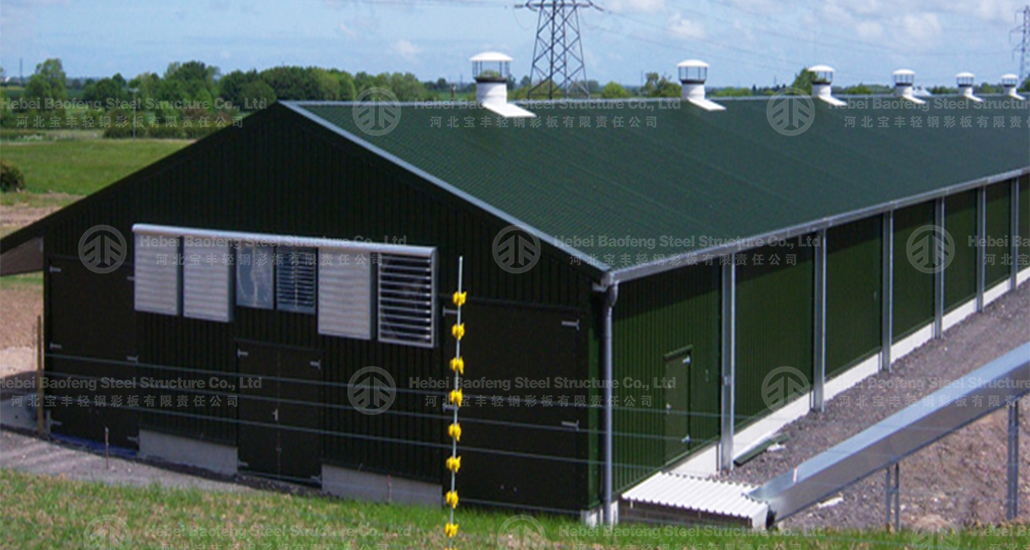
Important Considerations About Poultry Houses
When constructing or managing poultry houses, several important considerations must be taken into account to ensure the health, productivity, and welfare of the birds, as well as the efficiency and sustainability of the operation. Here are the key factors to consider:
1. Site Selection
Accessibility: Choose a location that is easily accessible for transportation of feed, equipment, and harvested birds.
Drainage: Ensure proper drainage to prevent water logging, which can lead to disease and structural damage.
Proximity to Resources: Locate the poultry house near sources of feed, water, and electricity to reduce operational costs.
Environmental Regulations: Comply with local zoning laws and environmental regulations regarding noise, odor, and waste management.
2. Building Design and Structure
Ventilation: Proper ventilation is critical to maintain air quality, control temperature, and reduce humidity. Install fans, vents, or automated systems.
Lighting: Provide adequate lighting for bird activity, feeding, and egg production. Use energy-efficient LED lights if possible.
Insulation: Insulate the walls and roof to regulate temperature and reduce energy costs.
Flooring: Choose durable, easy-to-clean flooring materials (e.g., concrete) with proper drainage.
Space Requirements: Ensure sufficient space per bird to prevent overcrowding, which can lead to stress and disease.
3. Temperature and Climate Control
Heating and Cooling Systems: Install systems to maintain optimal temperatures for different stages of bird growth (e.g., brooders for chicks, fans and misters for cooling).
Thermal Comfort: Monitor and adjust temperature and humidity levels to ensure bird comfort and productivity.
4. Hygiene and Biosecurity
Cleaning and Disinfection: Regularly clean and disinfect the poultry house to prevent the spread of diseases.
Footbaths and Sanitization Stations: Use footbaths and sanitize equipment to minimize contamination.
Restricted Access: Limit access to the poultry house to authorized personnel only to prevent disease introduction.
5. Feeding and Watering Systems
Automated Systems: Use automated feeders and drinkers to ensure consistent access to food and water.
Nutrition: Provide a balanced diet tailored to the age and type of poultry (e.g., broilers, layers, or breeders).
Water Quality: Ensure clean, fresh water is available at all times.
6. Waste Management
Manure Handling: Implement systems for efficient manure collection and disposal to prevent environmental contamination.
Odor Control: Use odor-reducing techniques, such as proper ventilation and manure management, to minimize unpleasant smells.
Recycling: Consider composting or recycling manure for use as fertilizer.
7. Health Monitoring
Veterinary Care: Regularly consult with a veterinarian to monitor bird health and address any issues promptly.
Vaccination Programs: Implement vaccination schedules to protect against common diseases.
Disease Prevention: Monitor for signs of illness and take immediate action to prevent outbreaks.
8. Automation and Technology
Monitoring Systems: Use sensors and monitoring systems to track temperature, humidity, and bird activity.
Data Analysis: Leverage data to optimize operations, improve efficiency, and enhance bird welfare.
Automation: Automate feeding, watering, and egg collection to reduce labor costs and improve consistency.
9. Sustainability
Energy Efficiency: Use energy-efficient lighting, heating, and cooling systems to reduce operational costs and environmental impact.
Renewable Energy: Consider solar panels or other renewable energy sources to power the poultry house.
Resource Management: Optimize the use of water, feed, and other resources to minimize waste.
10. Regulatory Compliance
Local Laws: Adhere to local regulations regarding poultry farming, including zoning, noise, and waste disposal.
Industry Standards: Follow best practices and guidelines set by agricultural organizations or certification programs.
11. Economic Considerations
Initial Investment: Assess the cost of construction, equipment, and setup.
Operational Costs: Factor in ongoing expenses such as feed, labor, utilities, and maintenance.
Return on Investment: Plan for profitability by optimizing production and reducing costs.
12. Future Expansion
Scalability: Design the poultry house with future expansion in mind to accommodate increased bird numbers or additional operations.
Flexibility: Choose systems and layouts that can be easily modified as needs evolve.
By carefully considering these factors, poultry farmers can create a productive, efficient, and sustainable environment for their birds while minimizing risks and maximizing profitability.

Categorias
último blog
Tag
© direito autoral: 2025 Hebei Baofeng Steel Structure CO.,LTD Todos os direitos reservados.

IPv6 rede suportada